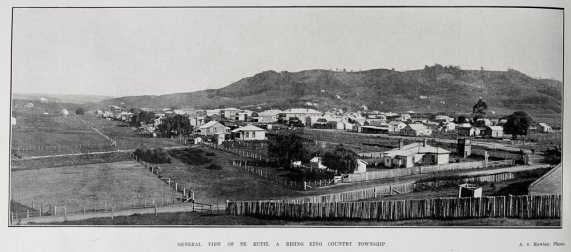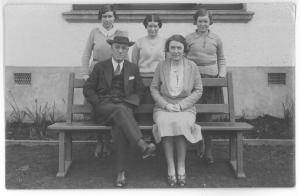About this time last year, I thought that my grandmother and her father, a Sinclair, were the only members of their family to migrate to New Zealand. Then, on learning my great grandfather’s name, James Sinclair, I discovered that he was living in Matakana (north of Auckland) in the early 20th century. He was living with his brother, Stephen Edward Sinclair, and Edward’s wife, Jessie (née Campbell).
Recently I have learned that two of Edward and James’ sisters also lived in New Zealand (mainly in Auckland) for over 40 years. They were Isabella Sinclair (1875-1965) and Evelyn Fullerton (née Sinclair, 1879-1953).
In the 1881 England, Census, Eveline Sinclair (4 years old) and Isabella Sinclair (6 years) are listed in the household of John Sinclair, tobacco manufacturer, at 26 Beverly Terrace, Cullercoats. Also in the household are Eveline and Isabella’s brothers, Stephen Edward Sinclair ( 7 years) and James Sinclair (20 years). In the 1891 England Census, Isabella Sinclair (16 years) is listed in the household of John Sinclair, along with her brother Stephen E Sinclair (17 years) and James Sinclair’s youngest child, Fannie Sinclair.
Evelyn (aka Eveline) married Doctor Francis W Fullerton (1870-1953) of Hull. The Shields Daily Gazette and Shipping Telegraph, Thursday July 6, 1899, includes a report of the marriage of the previous day at St George’s Church, Cullercoats:
The article, “Fashionable Wedding at Cullercoates”, reports that the bridesmaids were Dr Fullerton’s sisters, Edith and Katie, and Evelyn Sinclair’s sisters, Isabella and Grace. The best man was Dr Fullerton’s brother, Arthur Fullerton. The bride was given away by her brother John Sinclair. The article states that,
The bride wore a gown of rich ivory satin duchesse, handsomely trimmed with ivory Chantilly lace, and having transparent yoke of finely trimmed chiffon, and a skirt trimmed with pleated chiffon and lace. The upper drapery was finished with true lover’s knots and orange blossoms, and she also wore a wreath of orange blossoms and tulle veil, with a diamond, pearl, and ruby pendant, the gift of the bridegroom. The bridesmaids were attired in white China silk, handsomely trimmed with guipure lace, and shaded yellow chiffon sashes, and white chipped picture hats trimmed with roses, and they each carried lovely bouquets of white blossoms.
After the wedding there was a reception at the house of the bride’s mother. The newlyweds then left for their honeymoon in Scotland.
In the 1901 Census, Dr and Mrs Fullerton were living in Hull, with two servants, Margaret Carvin (20) and Eliza S Clark (23).
Before leaving England for New Zealand, the Fullertons had a daughter, Gwendoline Eveline Fullerton, probably born around 1905. The New Zealand Herald, 9 June 1908, p.4 lists Misses Fullerton (3), I. Sinclair, and Dr. F. W.Fullerton as passengers in the first saloon of the SS Cornwall. They had arrived the previous day in Sydney, from Liverpool and Melbourne. The New Zealand Herald on 19 June 1908, p.4, lists Misses Fullerton (3), I. Sinclair, Dr. F. W.Fullerton as passengers arriving in Auckland on the SS. Cornwall from England.
When they first arrived in New Zealand, Isabella and the Fullertons lived in Te Kuiti in the King Country.

General view of Te Kuiti, 1908. Photographer: A. S Hawley for Auckland Weekly News, 23 Jan, 1908. In Sir George Grey Special Collections, Auckland Libraries, AWNS-19080123-2-2
There is a newspaper advertisement for Dr. Fullerton in the King Country Chronicle, 30 August, 1909, p.2. It says that Dr, Fullerton “May be Consulted Daily at Mr Kerr’s Boarding House, Te Kuiti.”
Dr Fullerton’s brother, Walter Ernest Fullerton also lived in Waitomo and Te Kuiti. Initially, he was a farmer, later he was a manager of an Assurance Association.
The Fullertons and Isabella returned to England for visits on several occasions. In May, 1911 they returned to England for the coronation of King George V (22 June 1911). The Fullertons and Isabella planned to be away for 12 months. However, after about 6 months, they left London to return to New Zealand on The Orient liner Orsova (New Zealand Herald, 29 January 1912, Page 4).
Later in 1912, the Dr Fullertons and Miss Isabella Sinclair moved to the North Shore of Auckland. The King Country Chronicle, 6 November 1912, p.5, reports that they were leaving to live in Takapuna and were farewelled,
at the Bowling and Croquet Club’s ground, on Saturday afternoon last. A large number of their friends attended, which evidenced the esteem in which the guests had been held. Games of croquet and bowls were indulged in, and a delightful afternoon tea provided. Altogether a most enjoyable afternoon was spent. The greens were in excellent order and the bright and pretty costumes worn by the ladies made the scene an animated and pretty one. Subsequent to the afternoon’s gathering Mrs Fullerton was presented by her friends with a very handsome rose bowl and stand, also a gold pendant, Miss Sinclair receiving a silver-mounted manicure set. Sincere regret was expressed on all sides at the guests’ departure from Te Kuiti, and many good wishes extended to them for their future welfare.

Auckland’s favourite seaside resort: Holiday-makers on Takapuna Beach, on Boxing Day. Published in Auckland Weekly News, 2 January 1913. In Sir George Grey Special Collections, Auckland Libraries, AWNS-19130102-4-3
Dr. Fullerton was elected a councillor on the Takapuna Council. A 1913 report on the newly elected Takapuna Council lists Dr F. W. Fullerton as one of the Council members, but states that he was unable to attend the Mayor’s inauguration due to being “indisposed”. Dr. Fullerton was listed as being one of the members on a “Works Committee” that was set up. (New Zealand Herald, 2 September 1913, p.5,)
A 1914 article states that Takapuna Council member, Dr F. W. Fullerton had presented a report to the Council about the quality of water in Lake Takapuna. The report showed it was necessary to remove weeds from the lake, move the location of intake pipes, and to further monitor it for bacterial content. (New Zealand Herald, 17 December 1914, p.9).

Lake Takapuna (Lake Pupuke), c.1914. Creator: Frederick George Radcliffe. Sir George Grey Special Collections, Auckland Libraries, 35-R233
Dr. Fullerton was still a council member in 1916.
In 1919, the Fullertons and Isabella Sinclair moved across the harbour to Remuera in Auckland city. On leaving the North Shore, Dr F.W. Fullerton was presented with a leaving gift by the Takapuna Croquet Club. Speakers expressed regret that he was leaving to reside in Auckland. (New Zealand Herald, 18 February 1919, p.6).
To be continued…



